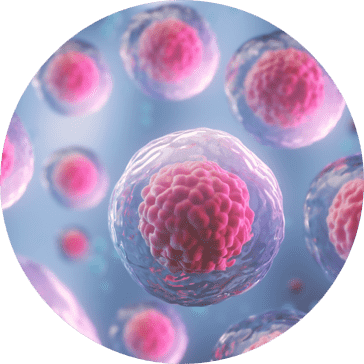Darier disease (DD), formerly referred to as Darier-White disease, is an uncommon inherited skin condition distinguished by greasy hyperkeratotic papules, nail changes, and lesions of mucosal surfaces. At Protheragen, we offer end-to-end preclinical drug and therapy development services on Darier disease that will facilitate your research project.
Introduction to Darier Disease
Darier disease (DD) is a rare autosomal dominant disorder caused by pathogenic variants in ATP2A2 on chromosome 12, which encodes sarco/endoplasmic reticulum calcium ATPase 2 (SERCA2). Disruption of SERCA2 impairs intracellular calcium signaling and keratinocyte adhesion. The prevalence is estimated to be 1 in 30,000-100,000 and the disease is characterized by incomplete penetrance and variable expressivity. Recent studies have suggested a role for dysregulated autophagy and endoplasmic reticulum stress in DD pathogenesis, driven by SERCA2 defect.
Pathogenesis of Darier Disease
- Genetic and Cellular Dysregulation: Darier disease is caused by heterozygous mutations in the ATP2A2 gene which encodes the SERCA2 protein. Heterozygous mutations in ATP2A2 leads to impairment of SERCA2 protein function to regulate calcium homeostasis, and a greater likelihood of ER stress as well as abnormal calcium signaling. Dysregulation of calcium homeostasis destabilizes desmosomal proteins leading to keratinocyte acantholysis and suprabasal cleft formation.
- Secondary Pathogenic Pathways: Increased ER stress and calcium imbalance can lead to secondary downstream mechanisms including defective autophagy and oxidative stress. Dysfunction of autophagy leads to the inability to clear damaged organelles, causing increased keratinocyte apoptosis, while increased reactive oxygen species (ROS) production damage cell membranes and adhesion proteins. Simultaneously, NF-κB mediated inflammatory pathways exacerbate impaired epidermal barrier, leading to hyperkeratosis and chronic inflammation.

Fig.1 Darier Disease pathophysiology and treatment. (Ettinger
et al., 2024)
Therapeutics Development for Darier Disease
Emerging therapeutics for Darier disease focus on biologics, gene-editing technologies, and small-molecule agents that restore dysregulated inflammatory pathways (e.g. IL-17/IL-23) while addressing the underlying genetic features of ATP2A2 pathology.
Table.1 Current Therapeutic Development for Darier Disease.
| Therapy Category |
Drug/Intervention |
Target |
Mechanism of Action |
Development Stage |
| Systemic Small Molecules |
Baricitinib |
JAK1/JAK2 |
Blocks pro-inflammatory cytokine signaling |
Phase II trials |
| Apremilast |
PDE4 |
Reduces cAMP degradation, modulates inflammation |
Phase II trials |
| Biologics |
Secukinumab (anti-IL-17A) |
IL-17A |
Neutralizes IL-17A-driven inflammation |
Preclinical |
| Guselkumab (anti-IL-23p19) |
IL-23p19 subunit |
Inhibits Th17 pathway activation |
Preclinical |
| Dupilumab (anti-IL-4Rα) |
IL-4Rα |
Blocks IL-4/IL-13 signaling |
Phase II trials |
| Gene therapy |
CRISPR-Cas9 editing |
ATP2A2 gene |
Corrects SERCA2 mutations |
Preclinical |
| siRNA-based therapy |
ATP2A2-targeted siRNA |
ATP2A2 mRNA |
Silences mutant ATP2A2 transcripts |
Preclinical |
Disclaimer: Protheragen focuses on providing preclinical research services. This table is for information exchange purposes only. This table is not a treatment plan recommendation. For guidance on treatment options, please visit a regular hospital.
Our Services
Protheragen can support the complete broad-spectrum of services to advance therapies for Darier disease. Our scientific team is made up of experienced scientists, dermatologists, and geneticists that will utilize next-generation technologies to advance your projects in therapeutic development and disease model development.
Therapeutic Development Platforms for Darier Disease
Disease Models Development for Darier Disease
Protheragen utilizes relevant and customized 2D cell models and 3D skin models to study DD relevant molecular pathologies with focus on ATP2A2/SERCA2 pathway dysregulation, calcium signaling, and cell adhesion defects. Our animal models recapitulate hallmark DD manifestations such as acantholytic skin lesions, hyperkeratotic plaques, and susceptibility to secondary infections, enabling robust evaluation of therapeutics targeting aberrant keratinocyte differentiation, inflammatory pathways.
- Patient-derived ATP2A2-mutated keratinocyte monolayers
- ATP2A2 pathogenic variant keratinocytes
- 3D human epidermal equivalents with ATP2A2 knock-in mutations
- Organotypic skin models with induced acantholysis
- Atp2a2+/− haploinsufficiency mice
- Tissue-specific double knockout (KRT5-Cre; Atp2a2flox/flox)
- Tamoxifen-inducible Atp2a2 knockout (KRT14-CreERT2; Atp2a2flox/flox)
- Thapsigargin-induced epidermal injury model
Protheragen is unique as a preclinical research services provider passionate about moving forward therapies for rare diseases like Darier disease. Our complete broad-spectrum of services cover all aspects of preclinical research services from target discovery, animal and disease model development, as well as drug safety evaluation and DMPK services. If you are interested in our services, please feel free to contact us.
References
- Ettinger, M., et al. "Darier Disease: Current Insights and Challenges in Pathogenesis and Management." J Eur Acad Dermatol Venereol (2024).
- Larney, C., D. Jobson, and M. Webster. "Grenz Ray Therapy for Darier Disease and Hailey-Hailey Disease: A Case Series of Three Patients." Australas J Dermatol 66.1 (2025): e28-e31.
All of our services and products are intended for preclinical research use
only and cannot be used to diagnose, treat or manage patients.



 Fig.1 Darier Disease pathophysiology and treatment. (Ettinger et al., 2024)
Fig.1 Darier Disease pathophysiology and treatment. (Ettinger et al., 2024)
